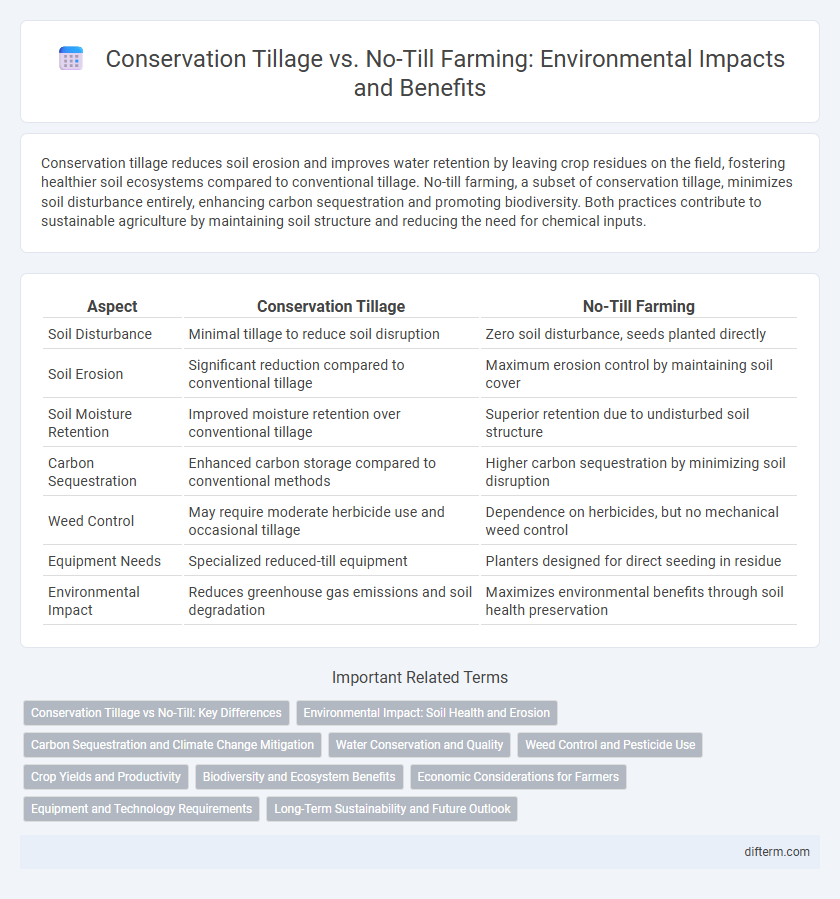Conservation tillage reduces soil erosion and improves water retention by leaving crop residues on the field, fostering healthier soil ecosystems compared to conventional tillage. No-till farming, a subset of conservation tillage, minimizes soil disturbance entirely, enhancing carbon sequestration and promoting biodiversity. Both practices contribute to sustainable agriculture by maintaining soil structure and reducing the need for chemical inputs.
Table of Comparison
| Aspect | Conservation Tillage | No-Till Farming |
|---|---|---|
| Soil Disturbance | Minimal tillage to reduce soil disruption | Zero soil disturbance, seeds planted directly |
| Soil Erosion | Significant reduction compared to conventional tillage | Maximum erosion control by maintaining soil cover |
| Soil Moisture Retention | Improved moisture retention over conventional tillage | Superior retention due to undisturbed soil structure |
| Carbon Sequestration | Enhanced carbon storage compared to conventional methods | Higher carbon sequestration by minimizing soil disruption |
| Weed Control | May require moderate herbicide use and occasional tillage | Dependence on herbicides, but no mechanical weed control |
| Equipment Needs | Specialized reduced-till equipment | Planters designed for direct seeding in residue |
| Environmental Impact | Reduces greenhouse gas emissions and soil degradation | Maximizes environmental benefits through soil health preservation |
Conservation Tillage vs No-Till: Key Differences
Conservation tillage involves minimal soil disturbance, leaving crop residue to protect the soil while enhancing moisture retention and reducing erosion, whereas no-till farming eliminates soil disturbance entirely, planting crops directly into undisturbed soil to improve soil structure and increase carbon sequestration. Conservation tillage often uses specialized equipment to manage residue and incorporates occasional tilling practices, while no-till relies on herbicides for weed control without mechanical disruption. The primary distinction lies in the level of soil disturbance and residue management, impacting soil health, biodiversity, and greenhouse gas emissions.
Environmental Impact: Soil Health and Erosion
Conservation tillage improves soil health by maintaining organic matter and enhancing microbial activity, which increases nutrient retention and soil structure stability. No-till farming significantly reduces soil erosion by leaving crop residues intact, protecting the soil surface from wind and water runoff. Both practices contribute to carbon sequestration, mitigating greenhouse gas emissions and promoting sustainable agriculture.
Carbon Sequestration and Climate Change Mitigation
Conservation tillage enhances carbon sequestration by maintaining crop residue on the soil surface, which increases organic matter and reduces soil disturbance, leading to higher carbon storage compared to no-till farming. No-till farming also promotes carbon retention but may face challenges like weed management that can limit its effectiveness in some regions. Both practices contribute to climate change mitigation by reducing greenhouse gas emissions and improving soil health, but conservation tillage offers a balance of soil aeration and carbon storage that can optimize long-term environmental benefits.
Water Conservation and Quality
Conservation tillage significantly enhances water conservation by increasing soil moisture retention and reducing runoff, which minimizes erosion and nutrient loss. No-till farming further improves water quality by maintaining soil structure and organic matter, leading to less sediment and chemical runoff into nearby water bodies. Both practices reduce the need for irrigation and protect aquatic ecosystems from pollution, supporting sustainable agriculture.
Weed Control and Pesticide Use
Conservation tillage reduces soil disturbance, which helps preserve weed seed banks and promotes natural weed suppression, leading to decreased reliance on herbicides compared to no-till farming. No-till farming eliminates soil disturbance entirely, often requiring targeted pesticide applications to manage weed populations effectively, but it can also enhance beneficial insect habitats that aid biological control. Both methods aim to optimize pesticide use, balancing effective weed control with environmental sustainability by minimizing chemical inputs.
Crop Yields and Productivity
Conservation tillage improves soil structure and moisture retention, leading to enhanced crop yields compared to conventional tillage methods. No-till farming minimizes soil disturbance, preserving beneficial microorganisms and organic matter, which supports higher productivity over time. Studies show that no-till systems often achieve comparable or superior yields, especially under drought conditions, by promoting better root development and soil health.
Biodiversity and Ecosystem Benefits
Conservation tillage and no-till farming both enhance biodiversity by preserving soil structure and promoting habitat for beneficial microorganisms, insects, and wildlife. No-till farming reduces soil disturbance, which helps maintain microbial diversity and improves nutrient cycling, supporting resilient ecosystems. These practices increase organic matter and soil moisture retention, fostering healthier plant growth and contributing to overall ecosystem stability.
Economic Considerations for Farmers
Conservation tillage reduces fuel and labor costs by minimizing soil disturbance, leading to immediate savings for farmers. No-till farming enhances soil moisture retention and organic matter, improving long-term crop yields and economic resilience. Both practices require initial investments in specialized equipment but offer significant economic benefits through increased efficiency and sustainability.
Equipment and Technology Requirements
Conservation tillage and no-till farming both require specialized equipment designed to minimize soil disturbance while optimizing seed placement and residue management. No-till farming relies heavily on advanced seed drills and planters equipped with coulters and disc openers to penetrate undisturbed soil effectively. Equipment for conservation tillage often includes modified tillage tools such as chisel plows and strip-till machines that balance residue retention with targeted soil aeration.
Long-Term Sustainability and Future Outlook
Conservation tillage enhances soil structure, moisture retention, and carbon sequestration, contributing to long-term agricultural sustainability and climate resilience. No-till farming minimizes soil disturbance, reduces erosion, and promotes biodiversity, supporting future crop productivity and ecosystem health. Implementing these practices helps mitigate climate change impacts while securing food systems for coming generations.
conservation tillage vs no-till farming Infographic

 difterm.com
difterm.com